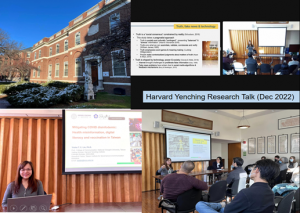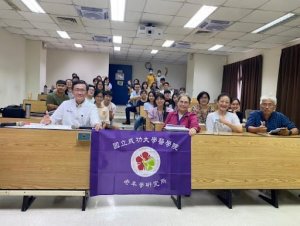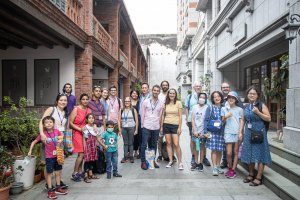When I visited Taiwan in the summer of 2002, there were no direct flights between the island and mainland China, Freedom Square was still called Chiang Kai-Shek Memorial Square, and the now diminutive Mitsukoshi tower was still the tallest building in Taipei. In my suitcase was a Sony Discman with electronic skip protection, along with about ten pounds of CDs with timeless hits like “Gonna make you sweat” by C+C music factory.
Though I only taught English in Taiwan for a few weeks, the experience as a college sophomore left an unexpectedly powerful impression on me. The food was great of course (I must have spent hundreds of dollars eating multiple bowls of shaved ice each day), but being in Taiwan also provided me with an invaluable ethnocultural reference point to understand interethnic relationships and minority identities outside the American context. However, one summer was far too brief, and I knew that I would need to return for a longer stay.
Applying to Fulbright
Eleven years later, a viable plan to return to Taiwan was conceived while visiting Taipei as a public health Fulbright student researcher in China. All Fulbright student fellows in China had been invited to Taipei to attend a series of lectures and workshops, and the Fulbright-Taiwan program was introduced to me for the first time. I began brainstorming on potential minority health research proposals with a Taiwanese colleague at National Dong Hwa University, and was elated when Fulbright-Taiwan awarded me with a Senior Scholar Postdoctoral grant to research unintentional injury among indigenous populations in Taiwan.
Unintentional injury and indigenous people in Taiwan
The estimated half million indigenous people of Taiwan today consist of 16 officially recognized tribes who have endured generations of socioeconomic and cultural marginalization by governing Dutch, Japanese, and Chinese authorities (1–4). Due in part to the legacies of these asymmetrical social structures, indigenous people in Taiwan have consistently lagged behind non-indigenous people in several basic social development indicators such as health (5, 6). According to a report by Taiwan’s Council of Indigenous Peoples, the life expectancy of an indigenous male born in 2011 was a full ten years shorter than that of a non-indigenous male (66 years vs. 76 years) (7).
One key factor underpinning this stark discrepancy in life expectancy is early death due to unintentional injury (e.g., traffic accidents, drowning, burns, poisoning, or falls). As of 2011, indigenous people in Taiwan were about three times likelier than non-Indigenous people to die of unintentional injury (7). For certain injuries, the indigenous/non-indigenous disparity is even more pronounced: among males, indigenous people are over 18 times likelier to die of drowning than non-Indigenous people (7).
From an international perspective, the 2011 standardized death rate due to unintentional injury among Taiwan’s Indigenous people was actually higher than that of India (67 vs. 58 deaths per 100,000 persons) (8), while the corresponding death rate among Taiwan’s non-indigenous population was lower than that of the United States (22 vs 39 deaths per 100,000 persons) (9).
In order for Taiwan to effectively address excess unintentional injury mortality among the indigenous community, it is imperative to better understand why mainstream injury prevention policies have been less effective for indigenous people and to develop intervention strategies better suited for the indigenous community. The Fulbright grant over the past eight months provided me with a unique opportunity to examine these issues at National Dong Hwa University, in collaboration with Taiwanese colleagues and organizations.
To better understand the mechanisms underpinning why indigenous people in Taiwan are more likely to die of unintentional injury, two Taiwanese PhD students and I have been conducting a systematic review of the existing Chinese and English literature. Numerous studies on the subject have already been published over the past thirty years, but to date there has not been a comprehensive synthesis of the extant literature. The process of mentoring students through the development of a scientific manuscript, and exchanging experiences and perspectives on ethnocultural issues in Taiwan and the US has been incredibly gratifying both professionally and personally. We aim to disseminate the results of our research in English and Chinese and are hopeful that the findings will help the effort to reduce unintentional injury mortality among Taiwan’s indigenous communities.
To better understand the effectiveness of a program to reduce unintentional injury death among Taiwan’s indigenous communities, colleagues from National Dong Hwa University, Tzu Chi University, and I conducted a trend analysis of unintentional injury death rates among indigenous Taiwanese from 2002 to 2013. Results suggest that there is limited evidence the program was responsible for lowering the rate of unintentional injury mortality among indigenous communities in Taiwan (10). To the best of my knowledge, this is one of the few quantitative evaluations of a program specifically designed for the indigenous populations in Taiwan.
One of the most memorable moments during my time in Taiwan was being able to attend community injury prevention meetings in Hualien County. Representatives from various academic, community, and social organizations were present to discuss indigenous injury trends and prevention efforts in the community. Attending these meetings afforded me an opportunity to witness how injury prevention programs were being implemented at the community-level and to connect with individuals committed to addressing injury among Taiwan’s indigenous population.
Life in Taiwan
Living in Taiwan for nine months also exposed me and my family to new experiences not possible during shorter trips to Taiwan. First, living away from the city required that I drive a car for the first time in Taiwan. Although I have been driving for almost twenty years, I was admittedly fairly anxious about driving in Taiwan, especially along narrow alleys and highway 9, AKA “death road” 死亡綫. I tend to be a fairly cautious driver (More than one Taiwanese friend has complained about how slow I drive), so it was a bit unsettling to see cars blatantly running red lights, driving in the motorcycle lanes, and illegally parked along the street, blocking traffic in the process. My anxiety was further heightened because I was specifically conducting research on unintentional injuries, and was acutely aware of the high death rates due to automobile crashes in Hualien County!
But as time wore on, I became more inured to such traffic violations, which eventually just blended in with the background of everyday life. Nonetheless, driving around the University’s main street (志學街) remains especially tricky because of the mix of pedestrians walking in the street, cyclists (often riding without rear lights), scooters, cars, and even full size tour buses. Fortunately, I’ve managed to make it this far without so much as a fender-bender. Knock on wood.
Second, my family and I had numerous encounters with the Taiwanese healthcare system over the past nine months. Earlier this year, my son had a persistent fever and we rushed him to the hospital ER based on instructions from a local physician. It was a rather stressful night (coincidentally on my birthday) because it was the first time we sent either of our children to the ER, but also because it was our first experience trying to navigate the Taiwanese healthcare system on our own. Fortunately, the on-call pediatrician at Tzu Chi General Hospital was able to quickly diagnose the Bronchopneumonia after some x-rays, and my son was back to his normal mischievous ways after a few days of antibiotics. Total cost of the ER visit? $3.20 USD.
Third, being in Taiwan for an extended period enabled my older son to enroll in a local Taiwanese pre-school. I don’t have a point of reference for pre-schools because this was the first time to send our children to any type of formal school, but I was shocked at how quickly his Mandarin skills improved in just a few short months. (The trade-off of course, is that his English proficiency remains pretty weak, but I suppose that’s another issue for another day.) Though he will have only spent nine months in Taiwan, the memories and language intuition which he has acquired will no doubt linger for much longer.
On a final personal note, living in Taiwan has allowed me to displace the imagined with lived experience. Having been raised in the US by parents who both grew up in Taiwan, I have long been curious about what life is like in this land which shaped the fundamental worldviews of my parents, but which remained both vaguely familiar and utterly foreign to me. Nine months later, Taiwan can still seem both vaguely familiar and utterly foreign, but only by personally experiencing Taiwan for an extended period of time have I been able to more fully appreciate the universal struggles, joys, and aspirations common to the people of Taiwan, America, and those in-between.
In short, living and conducting public health research in Taiwan has been tremendously rewarding, and neither would have been possible if not for the support of Fulbright Taiwan. For that I am immensely grateful.







